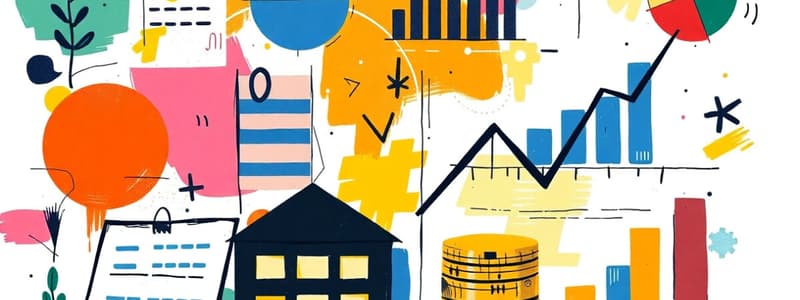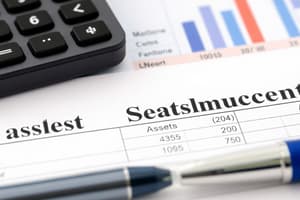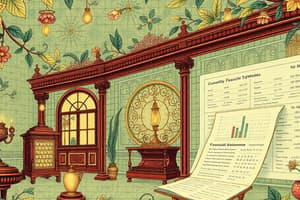Podcast
Questions and Answers
Which of the following assets is NOT depreciated?
Which of the following assets is NOT depreciated?
- Equipment
- Building
- Land (correct)
- Furniture and Fixtures
What is the purpose of an 'asset offset' or 'contra-asset' account, such as accumulated depreciation?
What is the purpose of an 'asset offset' or 'contra-asset' account, such as accumulated depreciation?
- To increase the value of the related asset.
- To track potential future expenses related to the asset.
- To reduce the book value of the related asset. (correct)
- To report the original cost of an asset.
Which of the following is an example of a long-term investment?
Which of the following is an example of a long-term investment?
- Investment in bonds (correct)
- Cash on hand
- Prepaid rent
- Accounts receivable
Which of the following best describes intangible assets?
Which of the following best describes intangible assets?
Which of the following is NOT a requirement for something to be considered a liability?
Which of the following is NOT a requirement for something to be considered a liability?
Which of the following is an example of equipment?
Which of the following is an example of equipment?
Why are future transactions not included when calculating liabilities?
Why are future transactions not included when calculating liabilities?
What is the meaning of settlement, in regards to liabilities?
What is the meaning of settlement, in regards to liabilities?
Which of the following best describes prepaid expenses?
Which of the following best describes prepaid expenses?
Which account is considered a contra-asset account?
Which account is considered a contra-asset account?
Which of the following is NOT a typical example of cash?
Which of the following is NOT a typical example of cash?
What distinguishes accounts receivable from notes receivable?
What distinguishes accounts receivable from notes receivable?
Under the imprest fund system, what is the primary purpose of the petty cash fund?
Under the imprest fund system, what is the primary purpose of the petty cash fund?
Which of the following accounts would most likely appear in the current assets section of a balance sheet?
Which of the following accounts would most likely appear in the current assets section of a balance sheet?
A company's advances to officers and employees are classified as what type of asset?
A company's advances to officers and employees are classified as what type of asset?
Which of the following characteristics best describes Property, Plant, and Equipment (PPE)?
Which of the following characteristics best describes Property, Plant, and Equipment (PPE)?
Which of the following is not a requisite for an item to be classified as an asset?
Which of the following is not a requisite for an item to be classified as an asset?
A company holds an investment with the intention of selling it within the next 9 months. According to the criteria for current assets, how would this investment likely be classified?
A company holds an investment with the intention of selling it within the next 9 months. According to the criteria for current assets, how would this investment likely be classified?
Which accounting element represents the resources controlled by a business as a result of past events?
Which accounting element represents the resources controlled by a business as a result of past events?
A company purchases raw materials with the intent to use them in production within its normal operating cycle. How would these raw materials be classified?
A company purchases raw materials with the intent to use them in production within its normal operating cycle. How would these raw materials be classified?
What is the primary requirement for an item to be considered a 'resource of the business' when classifying it as an asset?
What is the primary requirement for an item to be considered a 'resource of the business' when classifying it as an asset?
Which of the following best describes the concept of 'control' regarding asset classification?
Which of the following best describes the concept of 'control' regarding asset classification?
Which of the following is the best definition of accounting elements?
Which of the following is the best definition of accounting elements?
A business anticipates receiving a large sum of money from a customer in two years for a service that will be performed next year. How does this expectation affect the classification of assets?
A business anticipates receiving a large sum of money from a customer in two years for a service that will be performed next year. How does this expectation affect the classification of assets?
Which of the following represents income received in advance for services yet to be provided?
Which of the following represents income received in advance for services yet to be provided?
What distinguishes a finance lease from an operating lease?
What distinguishes a finance lease from an operating lease?
Which of the following payroll deductions represents amounts withheld from employees' salaries for income tax?
Which of the following payroll deductions represents amounts withheld from employees' salaries for income tax?
What is the fundamental characteristic of non-current liabilities?
What is the fundamental characteristic of non-current liabilities?
What distinguishes a mortgage payable from other types of long-term debt?
What distinguishes a mortgage payable from other types of long-term debt?
What does the equity section of a company's balance sheet primarily represent?
What does the equity section of a company's balance sheet primarily represent?
If a business borrows money from a bank with a repayment term of five years, how should this loan be classified?
If a business borrows money from a bank with a repayment term of five years, how should this loan be classified?
Which of the following payroll-related liabilities includes both the employee's contribution and the employer's share?
Which of the following payroll-related liabilities includes both the employee's contribution and the employer's share?
What effect do withdrawals have on capital?
What effect do withdrawals have on capital?
How is net income represented in the Statement of Financial Position (SFP)?
How is net income represented in the Statement of Financial Position (SFP)?
Which condition defines a net loss?
Which condition defines a net loss?
Which of the following best describes the impact of income on equity?
Which of the following best describes the impact of income on equity?
Which is not typically considered a revenue account?
Which is not typically considered a revenue account?
Which account reflects earnings from building rentals?
Which account reflects earnings from building rentals?
Which of the following is an example of gains?
Which of the following is an example of gains?
Expenses generally result in:
Expenses generally result in:
Which of the following is an expense account related to employee benefits?
Which of the following is an expense account related to employee benefits?
What is the purpose of the 'Bad Debts Expense' or 'Doubtful Accounts Expense' account?
What is the purpose of the 'Bad Debts Expense' or 'Doubtful Accounts Expense' account?
Which account is used to record the expired portion of premiums paid for insurance coverage?
Which account is used to record the expired portion of premiums paid for insurance coverage?
What is the primary difference between 'Store Supplies Expense' and 'Office Supplies Expense'?
What is the primary difference between 'Store Supplies Expense' and 'Office Supplies Expense'?
Which of the following accounts would a merchandising business use that a service entity typically would not?
Which of the following accounts would a merchandising business use that a service entity typically would not?
Which of the following merchandising accounts is presented as a deduction from sales in the financial statements?
Which of the following merchandising accounts is presented as a deduction from sales in the financial statements?
How are 'Sales Returns and Allowances' treated in the financial statements?
How are 'Sales Returns and Allowances' treated in the financial statements?
Which of the following best describes 'Miscellaneous Expense'?
Which of the following best describes 'Miscellaneous Expense'?
Flashcards
Current Assets
Current Assets
Assets that are expected to be converted to cash or used up within one year.
Prepaid Expenses
Prepaid Expenses
Expenses paid in advance but not yet incurred or used.
Accounts Receivable
Accounts Receivable
Amounts collectible from customers from credit sales not supported by promissory notes.
Notes Receivable
Notes Receivable
Signup and view all the flashcards
Allowance for Bad Debts
Allowance for Bad Debts
Signup and view all the flashcards
Cash on Hand
Cash on Hand
Signup and view all the flashcards
Petty Cash Fund
Petty Cash Fund
Signup and view all the flashcards
Property, Plant and Equipment (PPE)
Property, Plant and Equipment (PPE)
Signup and view all the flashcards
Salaries Payable
Salaries Payable
Signup and view all the flashcards
Interest Payable
Interest Payable
Signup and view all the flashcards
SSS Premium Payable
SSS Premium Payable
Signup and view all the flashcards
Unearned Income
Unearned Income
Signup and view all the flashcards
Mortgage Payable
Mortgage Payable
Signup and view all the flashcards
Long-term Bank Loan
Long-term Bank Loan
Signup and view all the flashcards
Equity
Equity
Signup and view all the flashcards
Finance Lease Liability
Finance Lease Liability
Signup and view all the flashcards
Land
Land
Signup and view all the flashcards
Building
Building
Signup and view all the flashcards
Machinery
Machinery
Signup and view all the flashcards
Equipment
Equipment
Signup and view all the flashcards
Accumulated Depreciation
Accumulated Depreciation
Signup and view all the flashcards
Intangible Assets
Intangible Assets
Signup and view all the flashcards
Liabilities
Liabilities
Signup and view all the flashcards
Requirements for Liabilities
Requirements for Liabilities
Signup and view all the flashcards
Capital
Capital
Signup and view all the flashcards
Owner's Equity
Owner's Equity
Signup and view all the flashcards
Withdrawal
Withdrawal
Signup and view all the flashcards
Net Income
Net Income
Signup and view all the flashcards
Net Loss
Net Loss
Signup and view all the flashcards
Revenue
Revenue
Signup and view all the flashcards
Gains
Gains
Signup and view all the flashcards
Service Income
Service Income
Signup and view all the flashcards
Salaries and Wages
Salaries and Wages
Signup and view all the flashcards
Rent Expense
Rent Expense
Signup and view all the flashcards
Office Supplies Expense
Office Supplies Expense
Signup and view all the flashcards
Utilities Expense
Utilities Expense
Signup and view all the flashcards
Depreciation Expense
Depreciation Expense
Signup and view all the flashcards
Sales
Sales
Signup and view all the flashcards
Sales Returns and Allowances
Sales Returns and Allowances
Signup and view all the flashcards
Merchandise Inventory
Merchandise Inventory
Signup and view all the flashcards
Accounting Elements
Accounting Elements
Signup and view all the flashcards
Assets
Assets
Signup and view all the flashcards
Non-Current Assets
Non-Current Assets
Signup and view all the flashcards
Requisites of an Asset
Requisites of an Asset
Signup and view all the flashcards
Contra-Account
Contra-Account
Signup and view all the flashcards
Owner’s Equity
Owner’s Equity
Signup and view all the flashcards
Study Notes
Chapter 3: Accounting Elements and Account Titles
- This chapter covers accounting elements and account titles, essential components in financial reporting.
- Accounting elements include assets, liabilities, capital/equity, revenue, and expenses.
- These elements are grouped together to summarize business transactions and activities.
Learning Objectives
- Understand the nature of accounting elements.
- Comprehend the broad classification of accounting elements.
- Identify the classification of assets.
- Recognize the criteria for classifying an item as a current asset.
- Define the operating cycle concept.
- List various account titles classified as assets.
- Explain the concept of "contra-accounts."
- Detail the characteristics and requirements of liabilities.
- Analyze elements impacting owner's equity.
- Discuss merchandising account titles.
Accounting Elements
- Assets are resources controlled by the business, resulting from past transactions, and expected to generate future economic benefits.
- Liabilities represent present obligations arising from past transactions, where settlement leads to an outflow of resources.
- Equity (or capital) represents the residual interest in the assets after deducting liabilities.
- Revenue encompasses increases in economic benefits from ordinary activities, not including contributions from equity participants.
- Expenses indicate decreases in economic benefits, such as the use of assets or the incurrence of liabilities.
Assets
- Assets are resources controlled by the business, with rights to future economic benefits.
- An asset must: be a resource of the business, be controlled by the enterprise, be the result of past events, and provide future economic benefits.
Current Assets
- Assets expected to be realized or consumed within the normal operating cycle or within 12 months of the balance sheet date.
- Includes cash, cash equivalents, collectibles (trade receivables), goods intended for sale, or inventory.
- Cash assets that are restricted for specific uses (not for ordinary operation) are not considered current.
Current Assets Accounts
- Cash: Money in hand or in the bank, checks, and other negotiable instruments.
- Petty Cash Fund: Money specifically earmarked for small expenses.
- Notes Receivable: Money owed to the business, supported by promissory notes.
- Accounts Receivable: Money owed to the business, not backed by a promissory note.
- Allowance for Bad Debts: An account for potential losses from uncollected receivables (a "contra-asset).
- Interest Receivable: Interest earned on notes receivable.
- Advances to Officers/Employees: Money owed by officers/employees to the business.
- Supplies: Office supplies purchased but not yet consumed.
- Prepaid Expenses: Expenses paid in advance.
Non-Current Assets
- Assets not expected to be converted to cash or used up within the normal operating cycle (over one year).
- Classification: Property, plant, and equipment; long-term Investments; intangible assets; other non-current assets.
- Property, Plant, and Equipment (PPE): Tangible assets used in production or other operations. Includes land, buildings, machinery, equipment, furniture, fixtures.
- Accumulated Depreciation: The sum of depreciation over the years, deducted from the related PPE.
- Long-term Investments: Investments that will be held for more than one year (e.g., stocks, bonds, subsidiaries).
- Intangible Assets: Non-physical resources (e.g., patents, copyrights, trademarks).
- Other Non-current Assets: Assets not categorized in other classifications.
Liabilities
- Liabilities represent present obligations of the business resulting in the outflow of economic benefits arising from past transactions.
- A liability must be a present obligation existing at the balance sheet date that arises from a past transaction and lead to future outflows of resources.
- Classifications include current and non-current liabilities.
Current Liabilities
- Current liabilities are obligations expected to be settled within the entity's normal operating cycle or within one year of the balance sheet date (or, if not expected, they do not have the unconditional right to defer the settlement).
- Account Titles: Accounts payable, notes payable, bank payable/loan payable, utilities payable, salaries payable, interest payable, SSS/Philhealth premium payable, withholding tax/income tax payable, unearned income/precollected income.
Non-Current Liabilities
- Non-current liabilities are obligations expected to be settled beyond the operating cycle (i.e., more than one year).
- Classifications include mortgages payable, long-term bank payables, non-current portions of long-term debt, finance lease liabilities.
Equity (or Owner's Equity)
- Represents the residual interest in the assets after deducting liabilities.
- Usually includes capital, withdrawals/drawings, net income/loss.
Income Accounts
- Show the increases in economic benefits from ordinary business operations (excluding contributions from equity participants).
- Includes revenue and gains.
- Revenue is a primary element arising during ordinary business activities. Gains may or may not be from ordinary activities.
Income Account Titles
- Service income: Income earned from services rendered.
- Professional income: Income earned by professionals.
- Rental Income: Income from renting properties.
- Interest Income: Income from loans or investments.
- Miscellaneous Income: Income not categorized in other accounts.
- Gains from Sale of Assets: Income from selling assets not typically sold in ordinary operations.
Expense Accounts
- Expenses decrease economic benefits by depleting assets or incurring liabilities.
- Types: salaries/wages, rent, office supplies, store supplies, insurance, interest, taxes, utilities, bad debts, depreciation, SSS contribution, Philhealth contribution, Pag-IBIG contribution, miscellaneous expenses.
Merchandising Accounts
- Specific account titles used for businesses dealing in goods.
- Account Titles: Sales, sales returns and allowances, sales discounts, purchases, freight-in, purchase returns and allowances, purchase discounts, merchandise inventory, cost of goods sold, freight-out.
Studying That Suits You
Use AI to generate personalized quizzes and flashcards to suit your learning preferences.




